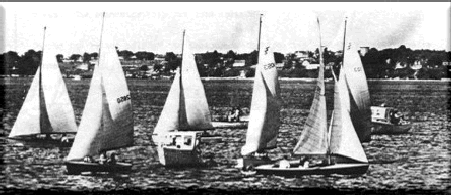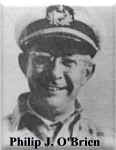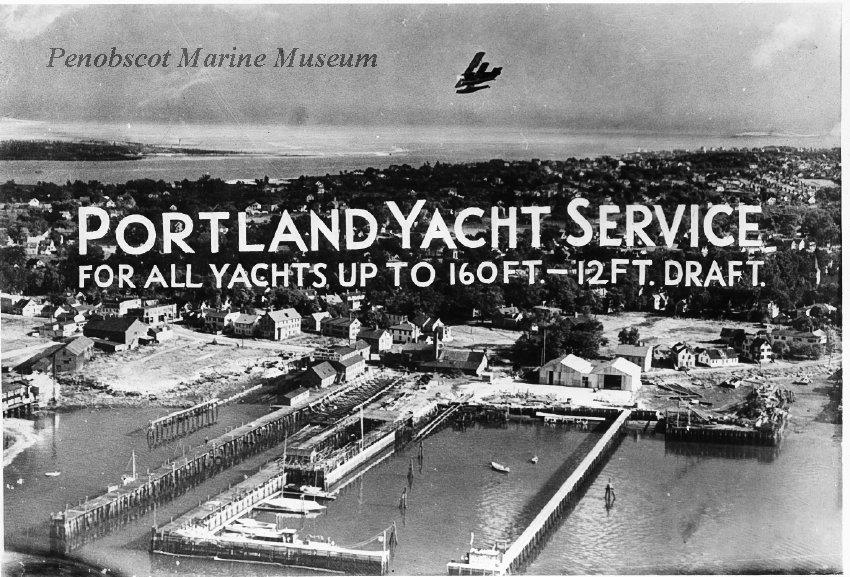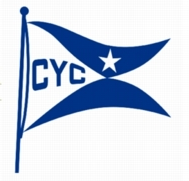
Contents
IntroductionIntroduction
This is a history more about events that have occurred over the last 50 years than about the people who made this half century of Centerboard Yacht Club reality. Including the stories about the ways in which members over the years met different challenges would have added a character to the history that is clearly missing, but this would have required far more time than this writer had available. For this I apologize.
It was written using minutes of meetings, Centerboarders, other documents, and interviews with Past Commodores, Charter and Life Members Al Moore and Herb Noyes. Al and Herb have been present during the first 50 years and have contributed significantly to the Club over this time. How many clubs or organizations have members with 50 years of service?
Different drafts were reviewed by Past Commodores John Dexter, Cush Hayward and Dick Ingalls, and Captain Herb Stone. It was primarily PC John who helped me keep a true course by always accepting the challenge to verify anything written. John also contributed significantly to the editing and the narrative. We disagreed occasionally. Commodore Ansel Tupper also reviewed the many drafts.
I know I am proud to be a member of CYC and proud to have been Commodore, although I might question the sanity of a Club that elects a Commodore who joined the Club in the early ‘70’s and did not know how to put the sails up on a boat. With the help of many members this improved and with their encouragement, my family and I actually learned to be competitive in racing a Lightning.
It is this support that members give to each other and the quality of the fellowship in the Club that the members during the first 50 years leave as a heritage to the members during the next 50 years.
Mark Twain once commented that the time a person spends fishing will be added to the life span. I believe the time spent as a member of CYC just may have the same result. I am not sure about the time spent as Commodore.
George F. Hackett, Commodore 1978/79
The Beginning

It may seldom be possible to establish exact dates when an organization had its beginnings for individuals may well interpret activities prior to some written record as the time the organization actually started. It is understandable then that there is disagreement as to the date Centerboard Yacht Club founded. Philip J. O’Brien, the first Commodore, in a message to the membership on March 4, 1938, clearly substantiates there was small-boat racing on Casco Bay during the summer of 1936. It is doubtful the decision to race occurred spontaneously while boats were being day sailed, but more likely skippers sat around talking about such an activity and planned the races. This seems like a plausible conclusion, for Commodore O'Brien in his message states, “The number of entries in these events disclosed the large number of boats actually located in the district and their owners' desire for opportunities to race.” Not only, then, had races probably been planned, but some method of communicating the schedule around the bay undoubtedly occurred.
Albert E. Moore, Commodore of Centerboard Yacht Club from 1944 through 1948, recalls that he and others as early as 1935 often met to talk about small boat racing and the possibility of forming a club to assure such racing opportunities. Past Commodore Moore also remembers that during the summer of 1935 frequent informal racing occurred and the planning for the races in the summer of 1936 included plans to present trophies for different places. These and other events eventually led to a notice being placed in the local newspapers in the winter of 1936/37 inviting all who would be interested in such an organization to meet and consider how to organize to conduct frequent regular racing on Casco Bay. The response resulted in the meeting of the small sail boat club of Portland Harbor on February 19, 1937. The meeting was held at the Harris Company, a grocery and marine supply store at the time, Commercial Street, Portland with a Mr. Gordon Davidson serving as chairman.
At the meeting a Mr. Elery Harris and Gordon Davidson were assigned to report at the next meeting on insignia, pennants and yachting caps. It was also agreed membership would be open in the club to anyone interested in the activities regardless of their ownership of a boat and that membership would be open to girls and women. The minutes of this first meeting list the names of twenty individuals as in attendance and Philip J. O’Brien was elect Commodore. The next meeting was scheduled for March 5, 1937.
The Name
The name, Centerboard Club, was adopted at a meeting on March 19,1937. The members present did not give any thought to the idea the word, yacht, should be included, but other name considered. The Udder Club was one tongue-in-cheek suggestion, by reference to the Portland Yacht Club, and this would permit the design of a rather distinctive burgee. On October 20, 1944, the name changed to the Centerboard Yacht Club, but it was not changed on the Club’s charter until 1981.
Whereas the club had been almost exclusively composed of members with sailboats in the 1930’s, 1940’s, and early 1950’s, by the middle of 1964 there were more powerboats than sailboats. Arguing then, the name Centerboard Yacht Club was now only a trade name, the issue of changing the name was discussed at the November 27, 1964, meeting. The challenge was not successful, but a second surfaced in June, 1967. This time it was proposed that the Club be called the South Portland Yacht Club. This was defeated.
The Burgee
The Purpose
The Clubhouse
 Late in 1944 a Clubhouse was a major issue and after considering different options, the old Ferry Terminal Building, owned by the City of South Portland, was selected. The building was on the waterfront at the end of Portland Street, basically an extension of Sawyer Street, and could provide a year round Clubhouse with the lease agreement, $1 per year, requiring that the Club maintain the city float. The first meeting at this location was May 4, 1945. The Club’s mast, which was first stepped at Davidson’s Boat Yard and later Merrill's Wharf where it remained until 1945, was moved to the grounds of the Ferry Terminal Building. Most members moored their boats generally in the anchorage currently used by the Club.
Late in 1944 a Clubhouse was a major issue and after considering different options, the old Ferry Terminal Building, owned by the City of South Portland, was selected. The building was on the waterfront at the end of Portland Street, basically an extension of Sawyer Street, and could provide a year round Clubhouse with the lease agreement, $1 per year, requiring that the Club maintain the city float. The first meeting at this location was May 4, 1945. The Club’s mast, which was first stepped at Davidson’s Boat Yard and later Merrill's Wharf where it remained until 1945, was moved to the grounds of the Ferry Terminal Building. Most members moored their boats generally in the anchorage currently used by the Club.
Early in 1962 it was learned that the property at 271 Front Street, South Portland, the current location of the Club, might be available. A committee was then formed to pursue the possibility of leasing or purchasing the property. On June 1, 1962, it was voted to lease this property from Verrier & Macgowan for 27 years and by November 3, 1962 a lease had been signed. The property did not have a building on it and might best be described as a run down pier strewn with debris. The first estimate to prepare the location as a Yacht Club was $40,000. This prompted the suggestion, “...perhaps alternative plans could be presented at the (next meeting) which would mean a lower overall cost." On August 3, 1962, it was reported that by eliminating some projects, the maximum cost for the new club would be $15,000. Even this was too high for the members and negotiations were initiated for the storage of club-owned equipment and the possibility of purchasing Bay boat service for the members. To make matters still more discouraging, it was reported at the February 14, 1963, meeting the wood bulkhead along the side of the property where the current launching ramp is located, had been lost in the last storm.
Unexpectedly it was learned that the Chevron Station at the corner of Cottage Road and Sawyer Street, South Portland was replacing their wood frame building and it could be purchased. The building was reported as 25’ by 38’ and the asking price was $200. The Club would have to move it to the Front Street location and this was done in the first week in May, 1963 at a cost of about $500. A concrete slab was poured to set the new clubhouse on and water and sewer lines were installed. A second building known as the Watkins Building and now the shed for lockers and stewards' use, was purchased for $100 and moved to the Club’s headquarters from its Cottage Road location for $150. Three club members loaned the Club the $150 to move the building and this was later repaid. The building was moved in September, 1963. This building was originally placed in what is now the club's parking lot near the launching ramp and was not moved to its current location until April, 1966. The original work to prepare this site as a yacht club included construction of the bulkheads.
On August 27, 1964, it was voted to allocate $75 to purchase a permit from the Harbor Commission to extend the present floats to a total of 300 feet. In January and February of 1965, the Club constructed 5 new floats using space at the Cott Bottling Company. Three of these were 8’ by 30’ and two were 8’ by 40’.
There was also considerable interest during this period in the purchase of property. References to creating an escrow account for this purpose are in the minutes and there is mention in the minutes of contacting the owner of the property at 271 Front Street to discuss a purchase. There was, then, a Development Committee appointed to pursue this issue, but the Committee was more visionary than its charge may have suggested. For instance, at the November 27, 1965 meeting it was announced the Committee was considering the purchase of an island for use by the Club. This would provide a place for picnics, camping, and a safe harbor for club members. On January 27, 1966, it reported that a number of towns had been contacted about the availability of an island for sale. Oh, what might have been!
By December of 1966 plans had been completed to dredge areas in the Fore River which involved the City of South Portland and marine businesses along the South Portland side including the anchorage used by Centerboard. This was welcome news, for this was clearly needed, but on December 1, 1966, the members were informed one marine business, “... pulled out of the deal for dredging and the plan has fallen through.” This was too important for the marine interests in the area, and by April, 1967, there was once again agreement to proceed with the plan. The dredging started around the middle of April, 1967, and the club’s anchorage was dredged to a depth of about 5’ at mean low water starting about 12’ from the bulkhead. There was subsequently a question raised about whether there was a permit for the dredging in the anchorage used by the Club, but this was resolved.
Although the club had voted on June 1, 1962 to lease the property at 271 Front Street for 27 years, this was not the lease actually signed. In March, 1968, the Club members were advised that a lease for the next 20 years was available and this had been executed by May, 1968. This agreement provided for a lease for 10 years at a monthly rent of $60 plus the payment of the property taxes and the club's option to renew the lease for another 10 years with an increase in rent of no more than 10%. This agreement would terminate June 30, 1988.
By the fall of 1970 it was recognized that the Clubhouse did not really accommodate well many Club activities. It was, then, proposed in November, 1970, that an expansion might appropriately be considered. There was agreement the Board of Trustees should proceed with the project, and in January, 1971, a loan for $2,500 had been negotiated for the addition. The addition was 18’ by 36’ and had basically been completed by July, 1971. Members contributed many hours to build this addition, which significantly changed ways in which the clubhouse could be used. This addition has often been referred to as the Ingalls’ Wing and the old meeting room as the Grand Hall. The club’s fireplace was installed during this construction.
Four other construction projects were completed during the early 1970’s. In the spring of 1972, a second dinghy float was built at the Clubhouse and the lockers in the shed were constructed. The large number of folding chairs and tables owned by the club were at this time simply stored in the main clubhouse area and often this restricted many activities. It was, then, proposed in November, 1972, that a shed be constructed, attached to the clubhouse for the storage of the chairs and tables and other club property. This was completed in the Spring of 1973. And during this time the club had experienced a somewhat significant increase in theft and vandalism, a security service was employed in the summers of 1973 and 1974, so it was decided a fence along the property on Front Street would be something of a deterrent. The fence was installed in the Spring of 1975, at a cost of $1,500, and originally this included a relatively large gate that could be locked. An agreement had to be executed so the fence would essentially enclose the property as about a third of the parking lot the club now uses was, and still is, owned by the South Portland Shipyard and Marine Railways Corporation. The City of South Portland installed a storm drain across the parking lot in 1973.
As early as 1976 there had been concern about the condition of the bulkhead in front of the clubhouse and the bulkhead near the launching ramp. By the Fall of 1978, this was now judged so serious repairs could no longer be postponed and the work was contracted out and completed in the Spring of 1979. Just days before Opening Day in 1979, the front “yard” was basically a large hole, though Opening was held on a “carpet” of grass as the day before the members had completely landscaped the area.
The connection to the South Portland sewer line was completed in October, 1977. Without adequate “fall” from the Clubhouse to front Street, this protect was made more expensive by the need to pump waste to the street.
Some important construction occurred during the 1980’s. An observation deck on the roof of the Club had long been a dream of many members and this was completed in the spring of 1984. The silting in of the anchorage, particularly near the floats, contributed to interest in extending the floats, for it is more expensive to dredge than seek permits and build floats. Two floats 8’ by 30’ were then constructed and the pilings were in place by August, 1986.


